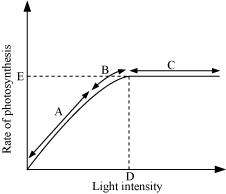 Short Answer Type
Short Answer Type Long Answer Type
Long Answer TypeFigure 13.10 shows the effect of light on the rate of photosynthesis. Based on the graph, answer the following questions:
(a) At which point/s (A, B or C) in the curve is light a limiting factor?
(b) What could be the limiting factor/s in region A?
(c) What do C and D represent on the curve?

 Multiple Choice Questions
Multiple Choice QuestionsA plant in your garden avoids photorespiratory losses, has improved water use efficiency, shows high rate of photosynthesis at high temperatures and has improved efficiency of nitrogen utilisation. In which of the following physiological groups would you assign this plant?
C4
CAM
Nitogen-fixer
Nitogen-fixer
Emerson's enhancement effect and red drop have instrumental in the discovery of
two photosystems operating simultaneously
photophosphorylation and cyclic electron transport
oxidative phosphorylation
oxidative phosphorylation
Specialised epidermal cells surrounding the guard cells are called
sunbsidiary cells
bulliform cells
lenticels
lenticels
The three boxes in this diagram represent the three major biosynthetic pathways in aerobic net reactant or products
Arrows numbered 4, 8 and 12 can all be
NADH
ATP
H2O
H2O
Chromatophores take part in
Photosynthesis
Growth
Movement
Movement
A.
Photosynthesis
Chromatophores are found in members of phototrophic bacteria. They contain bacteriochlorophyll pigments and carotenoids and take part in photosynthesis. In purple bacteria, such as Rhodospirillum rubrum, the light-harvesting proteins are intrinsic to the chromatophore membranes. However, in green sulphur bacteria, they are arranged in specialised antenna complexes called chlorosomes.
